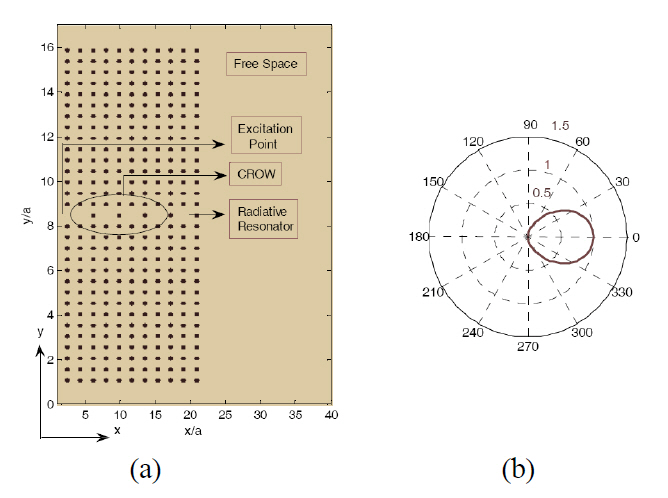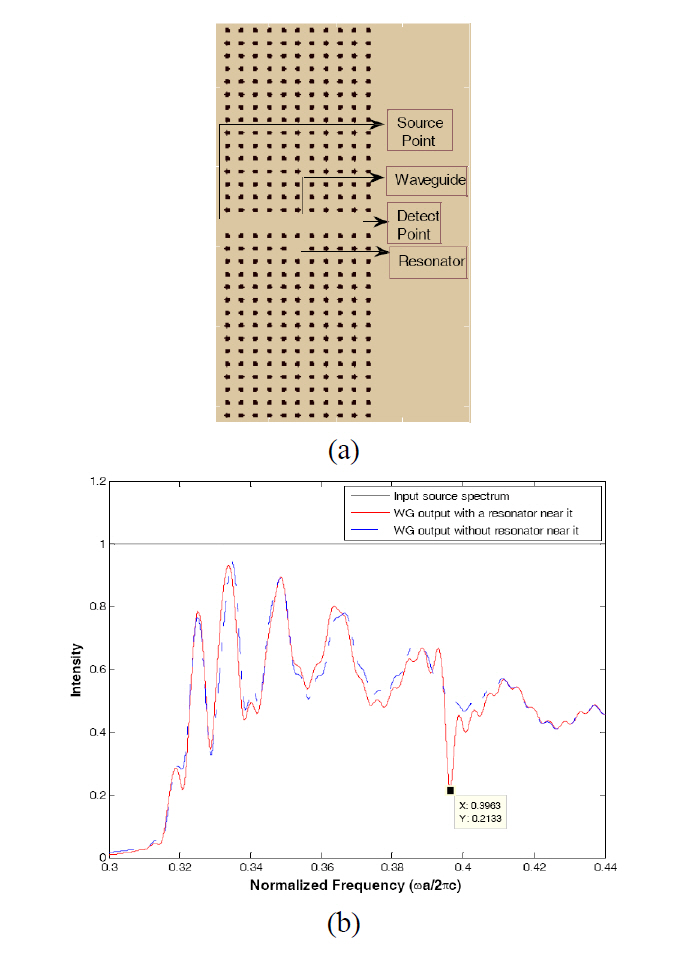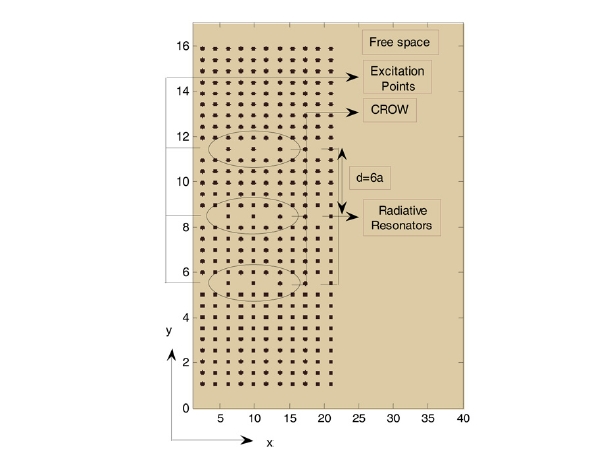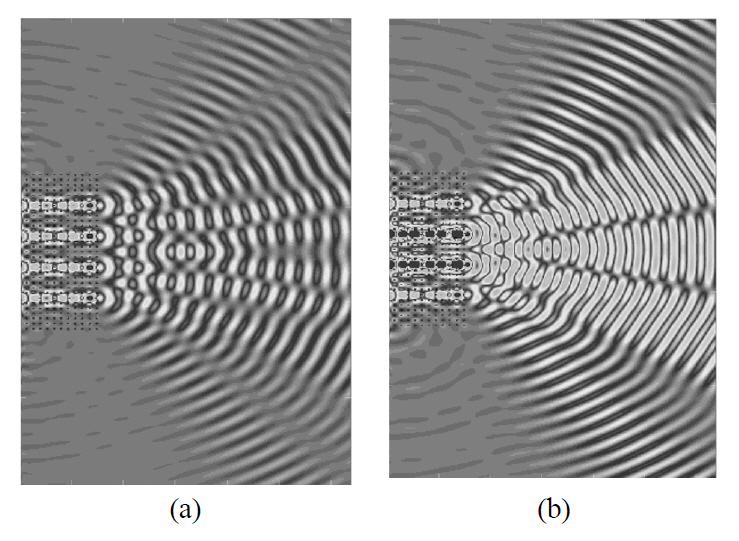



The beam shaping mechanisms of optical fields have attracted many researchers from the beginning of the study of electromagnetic fields [1-17]. Recently, it has been shown that beam shaping could be achieved by different kinds of photonic crystal structures due to their photonic band-gap properties [1-13]. One of the methods of beam shaping is engineering the surface modes via corrugations of the surface layer of the photonic crystal waveguide and appropriate termination of the waveguides [11, 18-21]. The defect placement, either point or line defects, at the termination side of the waveguide, modifies the pattern of the radiative beam [22-25]. For these kinds of photonic crystal structures, the mechanism of beam shaping is that the resulting optical field distribution at the photonic crystal exit resembles a multiple point source. The defect types and the arrangement of them, as point sources, cause a particular shape of light emission. The main aim of these studies is designing a particular radiative beam shape at the output of the photonic crystal structures, for example eliminating the side lobes and reducing the divergence angle of the main lobe to increase the directivity for better matching, or splitting the emitted beam for dividing the output light of the photonic crystal device to the next photonic crystal or conventional device in photonic integrated circuits (PICs) [8].
Photonic crystal resonators are special optical components for photonic integrated circuits (PICs). Coupled resonator optical waveguides (CROWs) are constructed with a chain of strongly confined ring resonators [26-29]. The pattern of emitted beam from a CROW surface of a photonic crystal waveguide shows the focusing effect [8].
These remind us of the behavior of the antenna arrays which makes it possible to derive more directional characteristics.The total field of the array is determined by the vector addition of the fields radiated by the individual elements.To provide very directional patterns, it is necessary that the fields from the elements of the array interfere constructively in the desired direction and interfere destructively in the remaining space [30-33].
In this paper, we have used the two dimensional finite difference time domain (FDTD) method to derive the pattern of the photonic crystal radiative defect arrays, and we compare the behavior with that of the antenna arrays.
II. DETAILS OF STRUCTURES AND SIMULATION SPACE
We have considered a photonic crystal structure with a square lattice of dielectric rods in air. The relative dielectric constant of the rods is 11.56, corresponding to the relative dielectric constant of InGaAsP-InP semiconductor at 1.55㎛ wavelength [8], and the cross-sectional radius is chosen to be 0.18a, where a is the PC lattice constant. For TM polarization with the electric field parallel to the rod axis, the photonic band-gap of the photonic crystal structure is in the normalized frequency (ω
In this paper, we have demonstrated the duality of the two structures of radiative photonic crystals, and antenna arrays. But there are some differences. First, the radiative field of a resonator is not analytically known. So, we cannot derive a formula, as in antenna arrays, for total radiative fields of the structure. Second, due to some mutual coupling of the resonators, despite the antenna array, the amplitude relation and the phase differences between the resonators are somehow out of our control. To overcome these two effects, we have used the FDTD method in a large space to calculate the far field, and for the latter we have chosen the distance between the resonators as large as to prevent the mutual coupling. Each resonator is excited by a separate source at the entrance of the waveguide linked to the resonator.Because of the similarity of each resonator excitation, the phase difference can be supposed to be zero. As an example FIG. 1 (a) shows the excitation point, CROW, and the radiative resonator for a single element radiative array, and FIG. 1 (b) shows its pattern, as the unit pattern in an antenna array that is mentioned in Appendix A.
The source is a modulated Gaussian:
where f0 is the resonant frequency of the resonator,
The normalized resonant frequency of the resonator (ω
In order to restrict the interference of the non-resonant frequencies in free space, we choose σ for a narrow spectrum bandwidth, to approach the monochromatic lightwave signal.Moreover, to achieve the more pure resonant frequency in the radiative resonator, we use CROW to link the excited points to the radiative resonator, due to the filtering behavior of CROW.
In this paper, the FDTD software was prepared in C++ and MATLAB and was carried on a Pentium 4 computer with processing capacity of 2.84 GHz and 3.25 GB of RAM.
III. THE COMPARISON BETWEEN PHOTONIC CRYSTAL RADIATIVE STRUCTURES AND ANTENNA ARRAYS
We have considered several photonic crystal radiative arrays by repeating FIG. 1 (a) structure in regular intervals of various multiples of
We have placed some detection points in free space at distances further than 10λ say
the array. The detection points are assumed to be at the angle of -90° to 90° with an angle interval of 3°. The amplitude of the electric fields of the detection points gives the total pattern of the arrays.
3.1. Effects of Variations of The Number of Radiative Elements
TABLE 1 shows the total pattern for an
figures such as
In the binomial excitation, as shown in TABLE 1, the same as antenna arrays, given in Appendix A, the minor lobes are eliminated. By increasing
3.2. Effects of Variations of The Elements Distance
TABLE 2
In the binomial excitation, as shown in TABLE 2, for a given
All the results follow the same variations as those of antenna arrays, described in Appendix A. The reasons for some minor exceptions are the mutual coupling between the photonic crystal CROWs, variation of the resonant frequency of single resonator and CROW that cause undesirable radiation by non-resonant frequency in free space,and the possibility of changing the phase of each radiative element in CROW path.
We have analyzed more cases of photonic crystal radiative arrays with various
In this paper, we have compared the behavior of photonic crystal radiative structures and antenna arrays for two types of uniform and binomial excitations. We found that there is a considerable duality between them. We can generalize the results to the other types of excitations such as Dolph-Tshebyscheff arrays, and to the other arrangement of radiative resonators such as any linear, planar and circular arrays of 3D photonic crystal termination resonators.Therefore, all the experiences in antenna arrays can be employed in manufacturing the photonic crystal beam shaping devices, in order to reduce the divergence of main lobe to enhance the directivity for better coupling, or splitting the emitted beam in order to divide the output beam to the next devices in photonic integrated circuits (PICs).
APPENDIX A. AN OVERVIEW OF BEAM SHAPING IN ANTENNA ARRAYS
There are at least five parameters and characteristics for shaping the overall pattern of the antenna arrays. These are the geometrical configuration of the overall array (linear,circular, rectangular, etc.), the relative distances of the elements, the excitation amplitude and phase of the individual elements, and the relative pattern of the individual elements.
The simplest and one of the most practical arrays are formed by placing N antenna elements along a line. For a uniform amplitude and spacing, the total field can be determined by multiplying the array factor (AF) of the isotropic sources by the pattern of the single element,called unit factor (UF). Array factor can be expressed in an alternate, compact and closed form [33]:
where
For
The direction of the main lobe does not change,
The main lobe becomes narrower,
The number of secondary or minor lobes is increased.
Also, for a given
The direction of the main lobe is changed,
The main lobe becomes narrower,
The number of secondary or minor lobes is increased.
Another case is the uniform spacing and non-uniform amplitude, an example of which is binomial arrays. The excitation coefficients of the binomial arrays for different values of
For example in a three element array that has the current ratio of 1:2:1, we can decompose this array into two 2-element uniform arrays, as shown in FIG. A.2, with element distance
So the array factor will be:
Thus, a general array factor formula for N elements array will be:
The array factor of 2-element uniform antenna array does not have minor lobes, thus, the binomial arrays will also be the same. By increasing
The number and direction of the lobes are not changed,
The lobe intensities are increased,
Hence, the directivity is enhanced,
For the same N, its lobe-width is more than that of the uniform one.
For a given
The number of lobes is increased,
The directions are changed,
The lobe-width is decreased [33-34].




![The excitation coefficients of the binomial arrays fordifferent numbers of array elements [33].](http://oak.go.kr/repository/journal/10756/E1OSAB_2010_v14n4_438_f011.jpg)
